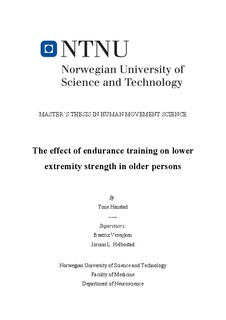| dc.description.abstract | Background and aim: The world’s population in general lives longer and are healthier than
earlier. Still, there are many neuromuscular changes that occur with increasing age. Age –
related decline in muscle mass, muscle cross sectional area and muscle force are typical
changes that can affect the ability to live an independent life and to function optimally in the daily life at older age. Many studies document the positive effect of strength training on lower extremity strength but there are only few studies that have been investigating if endurance training can have a positive effect as well. The main aim of this present study will therefor be to see if there is any effect of different types of endurance training on maximum leg force and maximum rate of force development among older persons.
Methods and materials: 387 men and women (born between 1936 – 1942) that participated in the three – year testing of the larger Generation 100 study, were included to this present study. The participants belonged to moderate intensity, high intensity or control groups and performed endurance training with different intensity in a three – year period. Effect of endurance training on peak force and peak RFD was tested by performing an isometric leg press, and further investigated using 4-way repeated measures MANOVA.
Results: At baseline women reported a higher activity level than men, but men reported a bit better self – perceived health than women. A larger amount of women was physically active for 30 minutes each day compared to men. There was no significant interaction between Time and Group, with indicates that the endurance training intervention has no significant effect on leg strength among the three groups. There was a significant interaction between Time and Gender, which indicated a smaller decline in peak force and peak RFD among women compared to men. There was also a significant interaction between Time and Side, which indicates that there were a larger decline in peak force and peak RFD in the right leg than the left leg from baseline to year three. The men had a larger difference in peak RFD values in right and left leg compared with women. It was neither any three – way or four – way interactions that was significant.
Conclusion: All participants had in average a significant decrease in lower extremity strength from baseline to year three. There was no significant effect based on what group in the intervention the participants belonged to. This indicates that endurance training has no effect on leg strength in older persons. | nb_NO |
